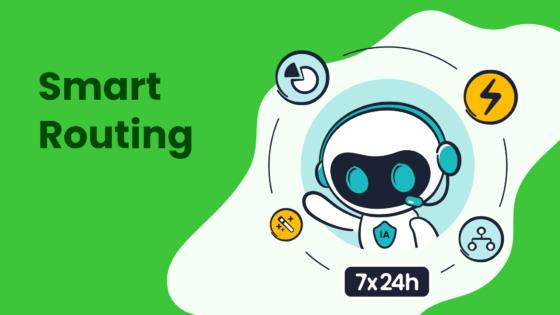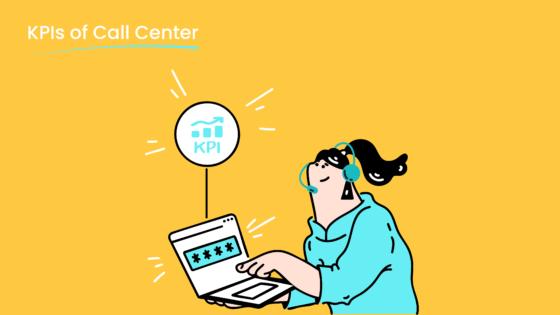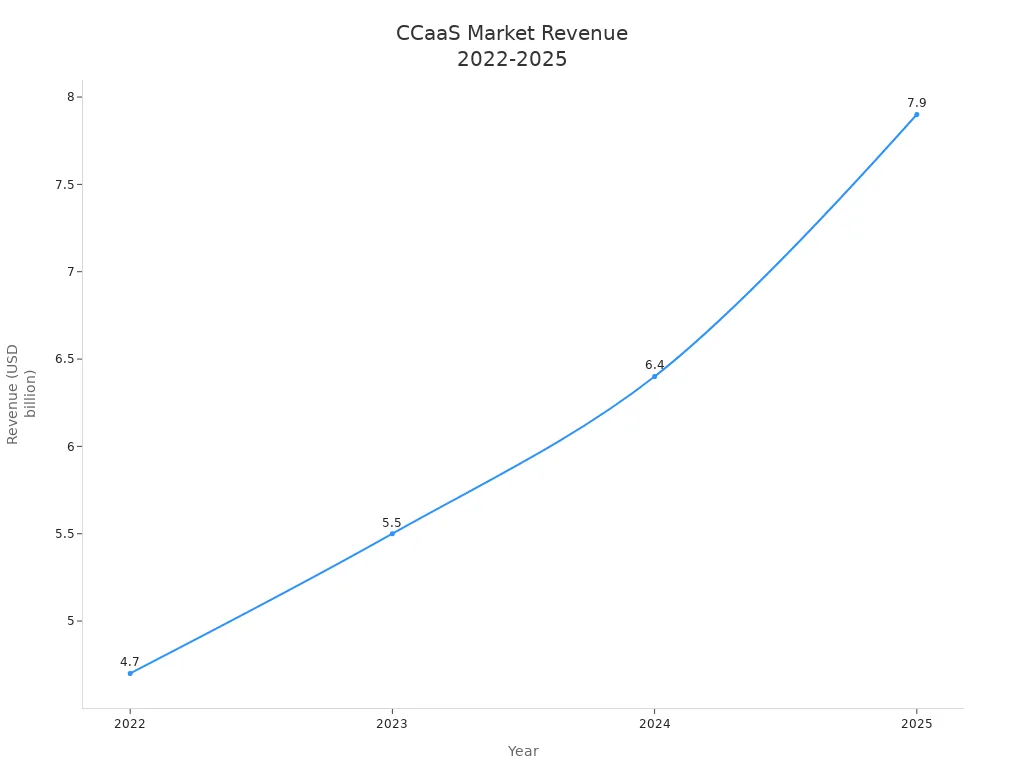Emerging Trends in Contact Center Strategy for 2025

Contact centers face a wave of emerging trends in 2025 that will define success. Generative AI, omnichannel engagement, and cloud-based solutions now drive digital transformation and customer experience. Sobot AI leads with advanced automation and unified platforms, helping brands adapt quickly. Rising customer expectations for speed and personalization make it vital to rethink contact center strategy. Consider these projected impacts:
| Trend | 2025 Projection | Impact |
|---|---|---|
| Generative AI adoption | 80% of organizations | Higher customer experience, agent efficiency |
| Omnichannel engagement market | $17.92 billion by 2030 | Seamless, integrated customer experiences |
| Increased call volumes | 61% of businesses | Greater need for scalable solutions |
Organizations that proactively embrace these trends will deliver standout customer experiences and stay ahead in a rapidly evolving landscape.
AI in Contact Center Strategy
Automation and Voicebots
Artificial intelligence is transforming contact center strategy in 2025. Companies now use ai-driven automation to handle routine customer requests, reducing wait times and operational costs. Sobot’s AI-powered Voice/Call Center and chatbot capabilities show how automation can improve efficiency and customer satisfaction. For example, OPPO used Sobot’s chatbot to manage high volumes of inquiries during peak shopping periods. This approach led to an 83% chatbot resolution rate and a 94% positive feedback rate, boosting overall satisfaction and repurchase rates.
- AI-powered automation enables 24/7 support, overcoming time zone barriers and ensuring consistent service.
- Voicebots can handle up to 10,000 calls at once, scaling operations without extra staff.
- Automation reduces call duration and increases first-contact resolution, leading to faster and more effective service.
- Companies report up to 60% lower operational costs and a 27% improvement in customer satisfaction scores.
- AI in the contact center also provides multilingual support and real-time analytics, allowing for personalized automation and better customer experiences.
Sobot’s solutions unify multiple channels, making it easier for agents to focus on complex issues while automation manages repetitive tasks. This deep ai integration helps organizations deliver higher satisfaction and loyalty.
Agent Assistance
AI in the contact center also supports agents with real-time guidance and training. Artificial intelligence tools analyze conversations as they happen and suggest solutions instantly. This approach improves first-contact resolution rates and reduces the need for call transfers.
- Real-time assistance gives agents immediate recommendations, helping them resolve issues quickly.
- AI-enabled training simulations help agents practice and improve their skills.
- Automated ticketing and categorization allow agents to prioritize and address issues efficiently.
- AI-driven automation ensures consistent responses and reduces errors, increasing customer satisfaction.
Sobot’s unified workspace combines these strategies, empowering agents to deliver better service. Artificial intelligence augments human roles, allowing employees to focus on strategic tasks while automation handles repetitive work. This balanced approach to contact center strategy leads to higher satisfaction and improved business outcomes.
Omnichannel Customer Experience

Unified Interactions
A renewed focus on omnichannel is transforming how brands deliver customer experience. Sobot’s Omnichannel Solution brings all customer interactions into a single, unified workspace. Agents can see the full history of every customer, no matter if they reach out by phone, chat, email, or social media. This unified view means customers never have to repeat themselves, and agents resolve issues faster.
Companies using unified interactions report higher customer satisfaction and loyalty. Metrics like Net Promoter Score (NPS), first contact resolution, and engagement rates all improve when agents have access to complete customer data.
Key benefits of unified interactions:
- Seamless, consistent customer journeys across all channels
- Faster and more accurate support
- Personalized attention for every customer
- Stronger brand identity and trust
| Channel Type | Measurable Benefits |
|---|---|
| Voice (Phone & VoIP) | Faster conversations, improved first contact resolution, better resource ROI |
| Web & In-App Chat | Lower average handle time, scalable support, fewer SLA breaches |
| Email & Ticketing Systems | Faster resolutions, improved satisfaction, structured management |
| Social & Messaging Apps | Consistent responses, stronger retention, reduced escalations |
| AI-Driven Chatbots | 24/7 support, lower cost-per-contact, handles volume growth |
Personalization
Personalization stands at the heart of a great customer experience. Sobot’s platform uses AI and real-time analytics to give agents the tools for 1:1 customer service. Agents see customer preferences, past purchases, and previous interactions, allowing them to offer tailored solutions.
Personalized attention leads to higher satisfaction and loyalty. For example, OPPO used Sobot’s AI-driven tools to reduce customer churn by 25% and boost retention by 30%. AI-powered sentiment analysis helps agents respond with empathy, while skills-based routing connects customers to the right expert quickly.
Personalization also means customers get proactive support. Sobot’s system can suggest answers or recommend products before customers even ask. This approach not only improves operational efficiency but also builds stronger relationships.
Companies that invest in personalization see up to 75% higher return rates and a 40% reduction in churn. Real-time data and AI make every interaction count, driving better customer experience and business growth.
Cloud Contact Center Technology


Cloud contact center technology is reshaping how organizations deliver customer service in 2025. Sobot’s cloud-based Voice/Call Center stands out with 99.99% uptime and a global network that spans 110 points of presence in 93 cities. This high availability ensures businesses can support customers worldwide, even during peak call volumes. Agents can work from any location, providing seamless service across time zones and languages.
Scalability
Scalability remains a core advantage of contact center technology. Companies can adjust agent numbers or add new channels quickly, matching resources to demand without investing in extra hardware. Sobot’s cloud-based technology allows organizations to scale up during busy seasons or scale down when demand drops. This flexibility helps maintain service quality and control costs.
- Businesses can add or remove agents instantly.
- Expanding to new markets or channels requires no infrastructure changes.
- Pay-per-license models align spending with actual usage.
- Remote access ensures consistent service, even with distributed teams.
Cloud contact centers handle fluctuating demand with ease. During promotions or holidays, companies can ramp up operations without service interruptions.
| Metric | Value / Projection | Year |
|---|---|---|
| Global CCaaS Market Revenue | USD 4.7 billion | 2022 |
| Global CCaaS Market Revenue | USD 5.5 billion | 2023 |
| Global CCaaS Market Revenue | USD 6.4 billion | 2024 |
| Global CCaaS Market Revenue | USD 7.9 billion | 2025 |
| Expected Adoption Rate of Cloud-based CCaaS | 60% of contact centers | 2025 |
| CCaaS Providers Incorporating AI-driven Tools | Over 50% | 2025 |

Integration
Integration is essential for modern contact center technology. Sobot’s platform connects seamlessly with CRM systems, analytics, and workforce management tools. This unified approach brings all customer data into one workspace, giving agents a complete view of each interaction.
- CRM integration enables automatic logging of calls and follow-ups.
- Unified profiles show purchase history and preferences.
- APIs allow easy addition of new business apps.
- Agents access all tools from a single dashboard, improving efficiency.
Cloud-based technology simplifies communication and data sharing. Teams can collaborate across locations, and updates happen automatically. This integration supports better decision-making and faster customer resolutions.
Sobot’s contact center technology empowers organizations to deliver reliable, flexible, and integrated customer service on a global scale.
Analytics and Contact Center Trends
Performance Insights
Analytics now drive the most important customer service trends in contact centers. Sobot’s real-time monitoring and analytics features give supervisors live dashboards to track agent activity, queue status, and customer interactions. This visibility allows managers to make quick decisions, such as shifting workloads or stepping in to help agents. Real-time alerts on key performance indicators like CSAT, NPS, and average handle time help teams spot issues before they grow.
| Aspect | Description |
|---|---|
| Key Performance Indicators | CSAT, FCR, AHT, NPS—analytics reveal inefficiencies and improve service quality. |
| Measurable ROI Examples | Companies cut employee costs by $5M, reduced handle time by 40%, and improved satisfaction by 10%. |
| Continuous Improvement Culture | Analytics promote transparency, coaching, and ongoing growth. |
Sobot’s unified workspace integrates speech and text analytics, so agents and managers see customer data in one place. This approach supports a culture of continuous improvement. Agents receive feedback based on real results, and coaching becomes more effective. Analytics also help identify skill gaps and create targeted training plans, which leads to better agent performance and higher customer satisfaction.
Predictive Analytics
Predictive analytics stands out among the latest contact center trends. AI-powered tools analyze historical and real-time data to forecast customer needs and segment users. Sobot’s analytics platform uses these insights to optimize call routing, matching customers with the best agents for their needs. This reduces wait times and increases first-contact resolution.
- Predictive analytics identifies early signs of customer dissatisfaction, allowing teams to act before problems escalate.
- It helps with staffing by forecasting call volumes, so managers can schedule the right number of agents.
- AI-driven insights support campaign management and proactive outreach, improving customer loyalty.
By using predictive analytics, contact centers move from reactive to proactive service. Sobot’s solutions help organizations anticipate customer needs, personalize interactions, and maintain high service quality. These customer service trends lead to better optimization, higher retention, and a stronger brand reputation.
Workforce and Agent Experience
Engagement
Contact centers in 2025 recognize that agent engagement drives better customer outcomes. Sobot’s unified workspace gives agents access to real-time data, AI-powered guidance, and seamless collaboration tools. These features help agents resolve issues faster and with greater confidence. When agents feel supported, they deliver higher-quality service and boost customer engagement.
Research shows a direct link between agent satisfaction and customer satisfaction. For every 1% increase in employee satisfaction, customer satisfaction scores rise by 1.3% (Glassdoor Study). Engaged agents stay longer, feel empowered to solve problems, and perform better. Sobot’s platform reduces repetitive tasks through automation, allowing agents to focus on meaningful conversations. This shift not only lowers stress but also increases motivation and retention.
Companies with highly engaged agents see lower turnover, fewer absences, and stronger customer loyalty. Sobot’s tools support career development, wellness programs, and recognition initiatives, all of which contribute to a positive workplace culture.
Flexibility
Flexibility has become a cornerstone of modern customer service strategies. Sobot’s cloud-based solutions support remote and hybrid work, enabling agents to work from anywhere. This approach increases job satisfaction and helps organizations tap into a wider talent pool. Flexible scheduling lets agents manage personal needs, reducing stress and improving well-being.
- Flexible work arrangements give agents more control over their schedules.
- Remote work increases agent happiness and retention by up to 20%.
- The ability to adjust shifts or take time off lowers job stress and boosts productivity.
- Employers benefit from higher engagement and reduced turnover.
Sobot’s platform uses automation and AI to optimize workforce management. Managers can scale teams up or down based on demand, ensuring consistent service quality. Unified workspaces and real-time updates remove data silos, making collaboration easy for distributed teams. These advances help contact centers deliver exceptional customer engagement while supporting agent well-being.
Security and Compliance
Data Protection
Security stands as a top priority in every contact center strategy for 2025. Contact centers handle sensitive customer information daily, making robust data protection essential. Sobot’s contact center technology uses secure, encrypted data transfer protocols such as TLS and AES-256 to protect data both at rest and in transit. This approach ensures that customer data remains confidential and safe from unauthorized access.
Contact centers face several pressing security challenges:
- Complex regulations like the 2025 TCPA update require constant compliance.
- Cybersecurity threats, including phishing and ransomware, continue to grow more sophisticated.
- AI-driven interactions demand transparency and accountability.
- Enhanced recording and retention policies require secure storage and clear processes.
- Regular compliance audits and leadership support are necessary for effective governance.
Sobot’s platform addresses these challenges with features like role-based access control, real-time monitoring, and automated quality management. The system’s 99.99% uptime and global reach support secure operations at scale. Encryption and multi-factor authentication further reduce risks, helping organizations meet standards such as GDPR, CCPA, and PCI DSS.
Secure data transfer protocols and continuous monitoring help contact centers maintain trust and regulatory compliance, supporting a positive customer experience.
Privacy
Protecting customer privacy remains a core part of any successful contact center strategy. Sobot’s contact center technology enforces strict privacy controls, ensuring only authorized personnel can access sensitive information. The platform supports regular audits, secure data disposal, and detailed record-keeping to demonstrate compliance.
Best practices for maintaining privacy include:
- Regularly reviewing user privileges to limit access.
- Enforcing secure data disposal for both digital and physical records.
- Conducting frequent security audits and risk assessments.
- Training staff on compliance requirements and privacy best practices.
- Using advanced technology to monitor and report on compliance.
Sobot’s unified workspace and compliance-enabling tools help organizations adapt to evolving regulations and customer expectations. By prioritizing privacy, contact centers build trust, reduce legal risks, and deliver a superior customer experience. These efforts ensure that security and compliance remain at the heart of every contact center trend in 2025.
The most impactful trends for 2025 highlight AI-powered agent assistance, advanced analytics, and highly personalized service. Sobot’s unified platform helps organizations adapt by integrating automation, omnichannel communication, and secure cloud technology. To future-proof operations, leaders should:
- Embrace AI and automation for smarter workflows.
- Prioritize seamless omnichannel engagement.
- Regularly assess technology, agent experience, and customer feedback.
Organizations that act now will deliver standout customer experience and stay ahead as trends evolve.
FAQ
What makes Sobot’s contact center technology stand out in 2025?
Sobot’s contact center technology delivers 99.99% uptime, global reach, and seamless integration with CRM systems. The platform supports AI-powered automation, omnichannel engagement, and advanced analytics, helping organizations improve customer experience and adapt to new contact center trends.
How does AI improve contact center strategy and agent performance?
AI in contact center strategy provides real-time assistance, automates routine tasks, and analyzes customer interactions. Sobot’s AI-powered tools help agents resolve issues faster, reduce errors, and increase first-contact resolution rates, leading to higher customer satisfaction and better business outcomes.
Why is omnichannel customer experience important for modern organizations?
Omnichannel customer experience ensures customers receive consistent support across all channels. Sobot’s unified workspace allows agents to view complete customer histories, improving response times and personalization. Companies using omnichannel solutions report up to 30% higher customer satisfaction scores (source).
How does Sobot ensure data security and compliance in contact center operations?
Sobot’s contact center technology uses encrypted data transfer, role-based access control, and regular audits. The platform complies with global standards like GDPR and PCI DSS, helping organizations meet strict privacy requirements and maintain customer trust.
What are the top contact center trends organizations should watch in 2025?
Key contact center trends include AI-driven automation, omnichannel engagement, cloud-based contact center technology, advanced analytics, and enhanced agent experience. Sobot’s solutions help organizations stay ahead by integrating these trends into a unified contact center strategy for superior customer experience.
See Also
Discover The Leading Cloud Contact Centers For 2025
Comprehensive Reviews Of Best Contact Center Solutions 2024
Best Cloud Contact Center Services Evaluated In 2024
